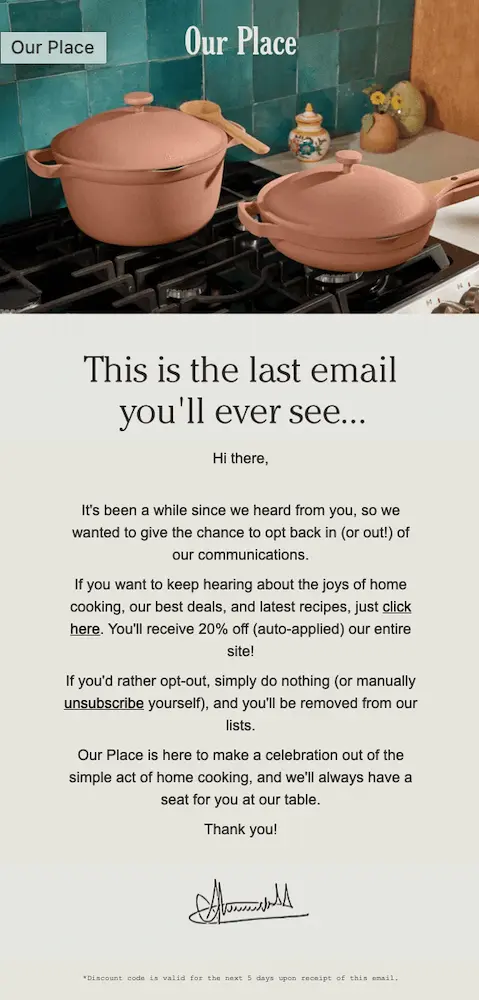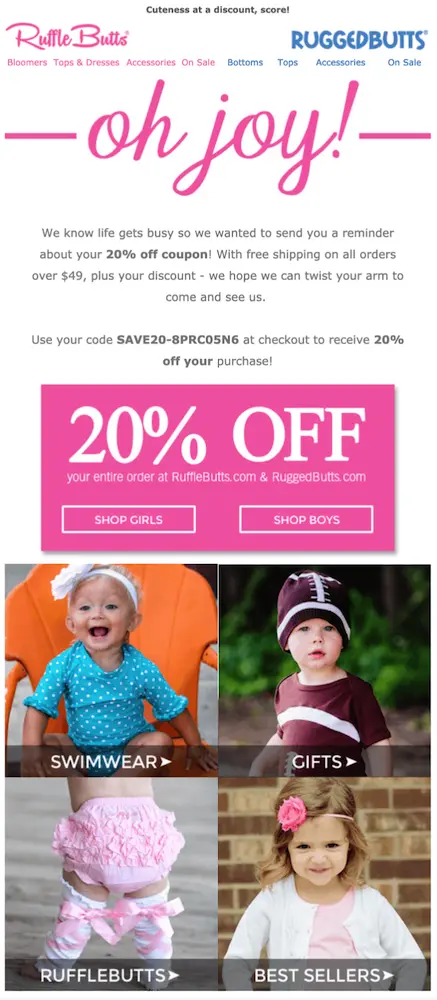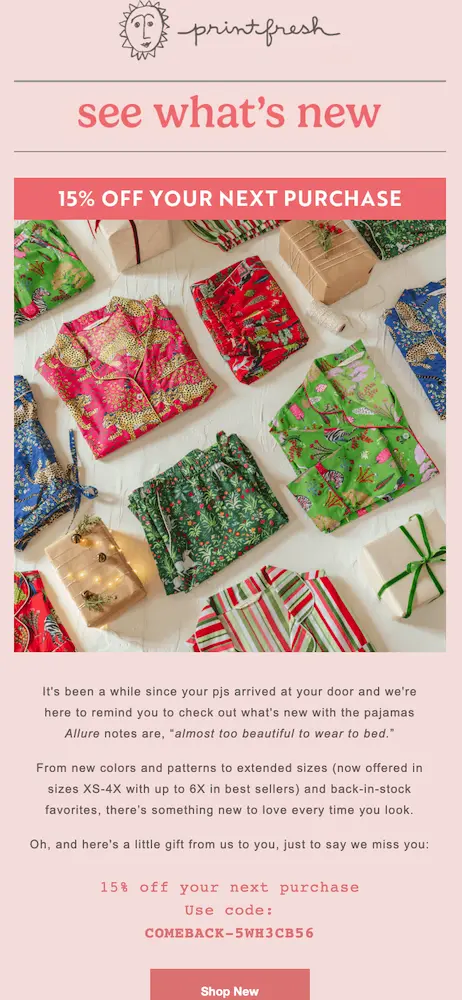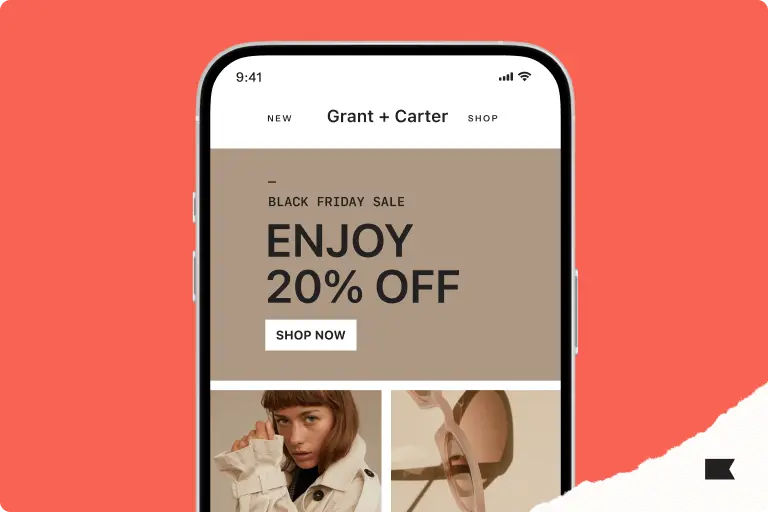Win-back email examples: strategies for rekindling customer relationships
You spent time (and money) acquiring each and every one of your customers.
If they stop engaging, should you take that as a cue to give up on them?
Not necessarily—and there’s no better way to persist than with a win-back email.
Whether someone stopped buying because they’ve defected to a competitor or they had a bad experience with your brand, it’s worth diagnosing and troubleshooting the problem—especially considering attracting a new customer costs 5x as much as keeping an existing one.
Win-back emails can help you suss out what caused a customer to lapse and address some of these concerns head-on. And they work: Research shows that 45% of subscribers who receive a win-back email will open future emails from your brand.
But we also understand that win-back emails can be intimidating—it’s hard to develop a creative way to say “we miss you” when you’re picturing an unengaged subscriber on the other end.
Here, we’ll teach you how to be strategic with your win-back email marketing strategy, with some examples and advanced tactics to guide you.
What is a win-back email?
A win-back email is an email you send to existing but inactive subscribers—people on your email list who previously visited your website, clicked on an email, or made a purchase, but haven’t bought from your store or opened your emails in a long time. The goal is to motivate them to interact with your business again.
Because win-back emails are for customers who exhibit certain behaviour (or lack thereof), you can set them up in your marketing platform to send automatically according to criteria you select ahead of time.
When you should send a win-back email
You can generally consider a subscriber or customer inactive after 3-6 months of inactivity, but your timeframe may differ depending on your products and sales cycle.
For example, if you sell mattresses, you wouldn’t mark someone inactive after a year of no purchases since your product is designed to hold up for a few years. On the other hand, if you sell coffee, you may consider someone inactive within that 3-6 month period.
“Find the timeframe where 75-85% of all customers would repurchase, and tee up your win-back messaging around this time,” suggests Jacob Sappington, head of email at Homestead Studio.
Find the timeframe where 75-85% of all customers would repurchase, and tee up your win-back messaging around this time.
Important note: Your marketing platform should allow you to customise your win-back window based on what makes sense for your product and sales cycle. People who haven’t purchased in 6 months? A year? BFCM-only shoppers from 3 years ago?
When you create a win-back flow in Klaviyo, you can be confident that your all-time data is always accessible—at no extra cost to you.
5 win-back email examples that work
Here are a few win-back email examples to help you better understand the strategies you can use to entice subscribers to come back to your brand.
1. Our Place puts the ball in the customer’s court

Subject line: “This is the last email you’ll see”
Email content: Kitchen essentials brand Our Place flips the narrative of their email so it feels like goodbye, but the recipient also has the option to formally opt out.
First, though, the email also includes a link to opt back in—and sweetens the deal with a 20% discount.
Email CTA: In keeping with the personal letter approach, the two calls to action (CTAs) in this email are subtly linked in the text itself, rather than pulled out as buttons.
The anchor text isn’t typical for a CTA, either—the first says, simply, “click here,” requiring the recipient to actually read the letter to understand what they’re clicking on. The second is an unsubscribe link, emphasising that the brand wants to give the customer full agency over their decision.
2. Rufflebutts entices people to re-engage with creative email copy

Subject line: “Oh Joy”
Email content: Kids’ apparel brand Rufflebutts reminds customers that they have a coupon for 20% off their next purchase and free shipping if they decide to shop with the brand again.
To show customers what they’re missing, the email features 4 collections, including swimwear, gifts, bestsellers, and the brand’s signature rufflebutts products with related imagery.
Email CTA: Rufflebutts does an excellent job of making it easy for customers to shop with them again, with clear, stand-out CTA buttons to shop either the boys’ or girls’ collections. Including both CTAs is also a great way to gather more data on shoppers’ preferences.
3. Printfresh focuses on exclusivity for customers

Subject line: “Let’s get reacquainted”
Email content: Sleepwear brand Printfresh leads with a 15% off discount in their win-back email, followed by a colourful product shot of various pyjama tops and bottoms folded up neatly on a gift-wrapping table. The visual makes it easy for the reader to re-familiarise themself with the brand’s products without clicking through to the website.
The email copy then goes on to explain that the discount offer is a “gift”—something they don’t hand out often—and references social proof in the form of a quote from Allure magazine that calls the brand’s pyjamas “almost too beautiful to wear to bed.”
Email CTA: The CTA in this email is centre-aligned, simple (“Shop new”), and impossible to miss—making it easy for customers who are ready to use that discount code to do so, right now.
4. Girlfriend Collective keeps it casual while giving users an incentive

Subject line: “We miss you. Here’s $20.”
Email content: Women’s activewear brand Girlfriend Collective keeps their win-back email subject line simple and straightforward and immediately tells subscribers that there’s an incentive to buy.
This email also takes the form of a letter written from the team. It’s addressed directly to the recipient and the copy is informal, as if the brand is speaking directly to the reader. The tone is casual, conversational, and inviting. Girlfriend Collective encourages the reader to check out new products and browse the website, but they aren’t pushy about it.
Email CTA: The only CTA in this email is the discount code itself, which forms the anchor text of a link that takes email subscribers directly back to Girlfriend Collective’s website.
The PS at the bottom, which communicates that the discount code is a limited-time offer, creates a sense of urgency and fear of missing out (FOMO)—encouraging customers to act quickly, lest they wait to buy and miss out on the offer.
5. Shhhowercap differentiates their product from competitors

Subject line: “Fancy Seeing You Again”
Email content: This re-engagement email from Shhhowercap is visually stunning, using imagery of the main product and its different patterns throughout to highlight exactly what the brand sells.
This brand does a stellar job of communicating the benefits of the product in their copy and showering readers with reasons to buy.
Instead of just including product pictures, Shhhowercap also mentions how their shower caps are differentiated from similar products by including descriptive details like “water repellent,” “breathable,” “anti-microbial,” and “machine washable.”
Email CTA: The “Shop 20% off” CTA makes this customer win-back email too enticing to resist.
3 advanced win-back email strategies for re-engaging customers
The examples above are straightforward, but there’s a lot you can do to elevate your win-back strategy so it’s even more effective.
With purchase behaviour analysis, experimentation, and omnichannel marketing, you can increase your chances that lapsed customers will buy from your brand again.
1. Use RFM analysis to trigger a win-back flow
A standard win-back flow is triggered when a customer or subscriber hasn’t engaged with your brand within a certain period of time. But what if you could go beyond the basics and trigger your flow based on past purchase behaviour—or even predicted future behaviour?
This is what RFM analysis accomplishes. “RFM” stands for recency, frequency, and monetary analysis, which is the grouping of customers based on their purchase behaviour—how recently they made a purchase, how frequently they purchase, and how much they spend.
This data analysis tool helps brands reduce churn—and under that umbrella is the win-back marketing automation.
For example, you can use RFM analysis to create a “needs attention” segment, then send that segment different variations of a win-back campaign. To go even further, you can separate high-value customers from the rest, so you’re sending a discount only to those VIPs who spend the most with your brand.
But the deeper power of RFM analysis is that it lets you stay ahead of churn. With an “at risk” segment, you can send multi-step messaging when a customer is close to churning but hasn’t yet—ultimately reducing the need to come out guns blazing with a win-back campaign in the first place.
2. Experiment with more than one win-back email
One of the trickiest parts of a win-back automation is deciding how many emails to send.
You could just send one win-back email, but there’s a chance the recipient could miss it or decide not to open it, especially if they haven’t opened one of your emails in months.
That’s why many marketers experiment with an email sequence—two or more win-back emails, with time delays in between—to increase the odds the recipient will open, engage, and, hopefully, click through to make their next purchase.
Here are some tips for deciding how many emails to include:
- To get the most out of your win-back series without risking your sending reputation or deliverability, send 2-5 emails.
- Segment your win-back series. For example, you could send a single email to any inactive customers or subscribers, then trigger a second and possibly third email to those who still haven’t made a purchase after a certain amount of time.
- If you notice revenue per recipient starting to drop after the first win-back email, that’s a good indicator that you can pull back on the number of emails you’re sending.
Practice makes perfect, here. “A lot of brands already know they are leaving money on the table by not fully addressing the customer lifecycle, and they lack solutions for efficient repeat purchasing,” explains Andrew Rosensweig, strategist at Electric Eye. “Get data, learn, and iterate to improve the tailored messaging that will effectively cultivate repeat customers.”
Get data, learn, and iterate to improve the tailored messaging that will effectively cultivate repeat customers.
3. Use an omnichannel approach for your win-back communications
We’ve been focusing on email as a primary win-back channel because it’s the easiest to execute, but we don’t want to leave the impression it’s your only option. The most effective win-back efforts are omnichannel, meaning that several channels work together to create a cohesive experience for the customer.
For example, if someone has subscribed to your brand’s texts in the past, they may be more willing to act on the urgency of a “last chance” discount SMS marketing. In that case, you may want to start with email, then follow up with a text message.
For people who still need a push after that, consider offering a dynamic coupon via a retargeting campaign on social media—a more expensive option, but likely still cheaper than acquiring a new customer from scratch.
Related content

Migrating to Klaviyo? Get expert insights on timing, tools, and tips to maximize your impact before Black Friday & Cyber Monday.

Explore Black Friday Cyber Monday email examples from top brands like Beyond Yoga and Twinings. Learn what worked, get expert tips, and see their successful results.

Learn more about the best time to send marketing emails. Pinpoint the optimal time to capture user attention to boost engagement and ROI.